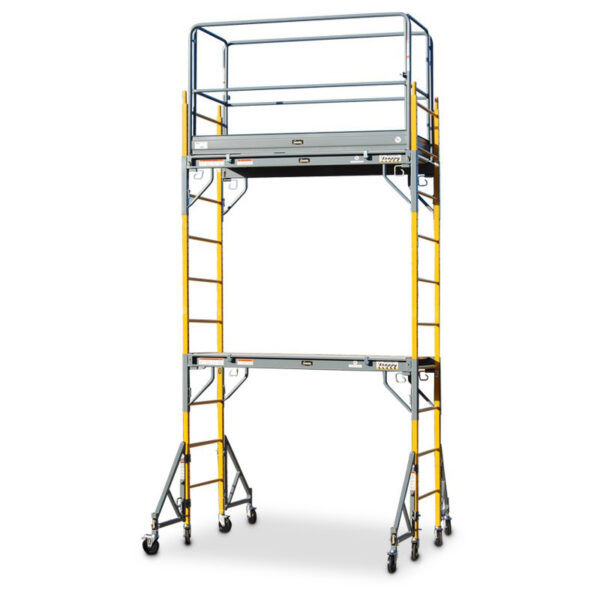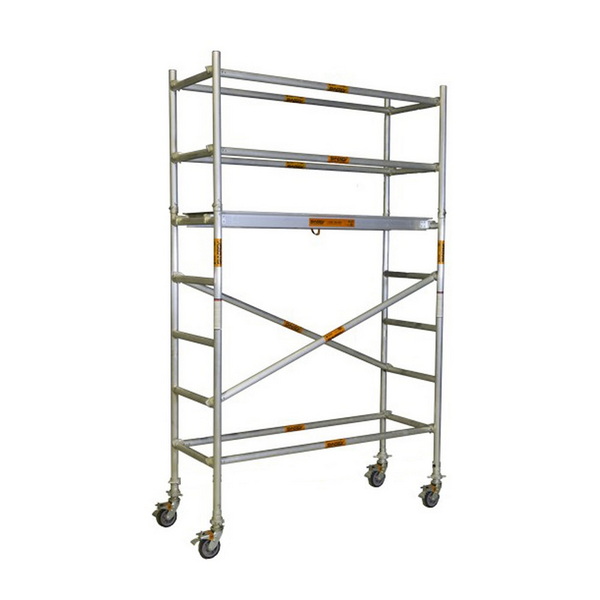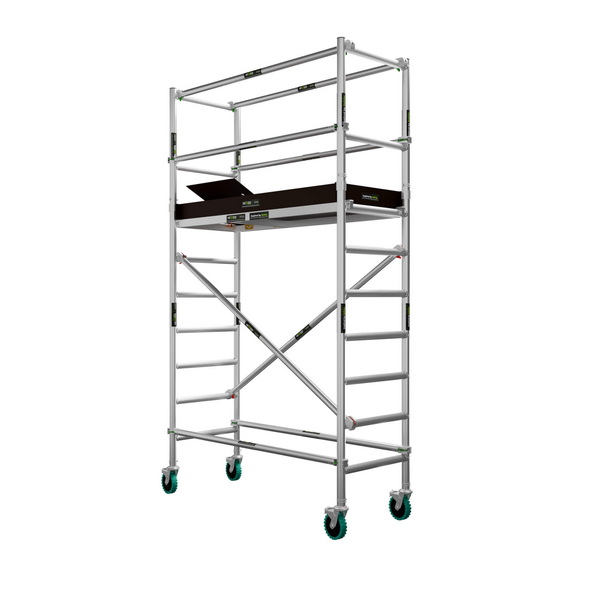Content Menu
● Introduction to Aluminum Scaffolding
● Components of Aluminum Scaffolding
● Safety Standards for Aluminum Scaffolding
>> OSHA Guidelines
>> ANSI and ISO Standards
● Benefits of Aluminum Scaffolding
● Safety Tips for Handling Aluminum Scaffolding
● Proper Assembly and Maintenance
● Fall Protection Measures
>> Guardrail Height
>> Personal Fall Arrest Systems
● Conclusion
● FAQ
>> 1. What are the primary safety standards for aluminum scaffolding?
>> 2. How do I ensure the stability of aluminum scaffolding?
>> 3. What are the benefits of using aluminum scaffolding?
>> 4. What safety equipment is required when using aluminum scaffolding?
>> 5. How often should aluminum scaffolding be inspected?
● Citations:
Aluminum scaffolding has become a staple in the construction industry due to its lightweight, durable, and versatile characteristics. However, ensuring safety standards are met is crucial when using aluminum scaffolding in potentially hazardous environments. In this article, we will delve into the safety aspects of aluminum scaffolding, explore its benefits, and discuss how to ensure safe usage.

Introduction to Aluminum Scaffolding
Aluminum scaffolding is favored for its ease of assembly and disassembly, making it ideal for indoor and outdoor projects such as maintenance, cleaning, and decoration. Its lightweight nature allows for easier transportation and handling on-site, which can significantly reduce labor costs and enhance project efficiency.
Components of Aluminum Scaffolding
- Frames: These are the main structural components of aluminum scaffolding, typically made from lightweight aluminum alloys. They provide the framework for the entire structure.
- Platforms: These are the working surfaces where workers stand. They must be fully decked or planked to ensure a stable and safe working environment.
- Guardrails: These are essential for preventing falls and are typically installed around the perimeter of the scaffolding.
Safety Standards for Aluminum Scaffolding
Safety standards for aluminum scaffolding are set by various organizations to ensure that scaffolding structures are reliable and secure. In the United States, the Occupational Safety and Health Administration (OSHA) plays a crucial role in establishing these standards. OSHA requires that all scaffolding must be capable of supporting its own weight and at least four times the maximum intended load without failure[1][4].
OSHA Guidelines
- Load Capacity: Scaffolding must support at least four times the maximum intended load.
- Fall Protection: Guardrails and personal fall arrest systems are mandatory for heights above a certain level.
- Regular Inspections: Conduct regular inspections before each work shift and after any incident that could affect structural integrity[4].
ANSI and ISO Standards
The American National Standards Institute (ANSI) and the International Organization for Standardization (ISO) also provide comprehensive guidelines for scaffolding safety. ANSI A10.8-2011 covers safety requirements for scaffolding in the construction industry, while ISO standards offer global guidelines for quality management systems applicable to scaffolding[1].
Benefits of Aluminum Scaffolding
Aluminum scaffolding offers several benefits that make it a preferred choice in construction projects:
- Lightweight and Portable: Easy to transport and handle, reducing labor costs and enhancing project efficiency.
- Quick Assembly and Disassembly: Saves time and increases productivity on-site.
- Corrosion Resistance: Aluminum alloys are resistant to corrosion, ensuring durability over time.

Safety Tips for Handling Aluminum Scaffolding
Ensuring safety when using aluminum scaffolding involves several key practices:
1. Inspect Before Use: Check all components for damage or corrosion before each use.
2. Use Personal Protective Equipment (PPE): Ensure workers wear appropriate PPE, such as helmets and harnesses.
3. Ensure a Stable Base: Set up scaffolding on a level, solid foundation using base plates or adjustable feet.
4. Limit Load Capacity: Do not exceed the recommended weight capacity, and distribute materials evenly.
5. Secure Wheels on Mobile Scaffolding: Prevent movement by securing wheels on mobile scaffolds[5].
Proper Assembly and Maintenance
Proper assembly is critical to ensuring the stability and safety of aluminum scaffolding. A common cause of scaffolding accidents is incorrect assembly, which can result in structural failures[1].
- Level Base: Begin with a level and stable base to prevent the scaffold from tipping over.
- Secure Components: Ensure all couplers, locks, and cross braces are secure and functioning properly.
Fall Protection Measures
Fall protection is a critical aspect of scaffolding safety. Guardrails are typically used to prevent falls, but personal fall arrest systems are also required for certain configurations[3][4].
Guardrail Height
Guardrails must be installed at a height that prevents workers from falling. In most jurisdictions, guardrails are mandatory for heights above a certain level.
Personal Fall Arrest Systems
These systems are essential for workers on scaffolds at heights where guardrails are not feasible. Ensure all fall protection equipment is properly maintained and used correctly.
Conclusion
Aluminum scaffolding is a safe and efficient tool for construction projects when used correctly. By adhering to safety standards, conducting regular inspections, and ensuring proper assembly and maintenance, the risks associated with scaffolding can be minimized. Understanding the benefits and safety considerations of aluminum scaffolding is crucial for enhancing project efficiency and worker safety.

FAQ
1. What are the primary safety standards for aluminum scaffolding?
The primary safety standards for aluminum scaffolding include OSHA guidelines that require scaffolding to support at least four times the maximum intended load and the use of fall protection systems. ANSI and ISO standards also provide comprehensive guidelines for scaffolding safety[1][4].
2. How do I ensure the stability of aluminum scaffolding?
Ensure stability by setting up scaffolding on a level base, using base plates or adjustable feet on uneven ground, and securing all components properly[1][5].
3. What are the benefits of using aluminum scaffolding?
Aluminum scaffolding is lightweight, portable, easy to assemble and disassemble, and offers corrosion resistance, making it ideal for various construction projects[2][5].
4. What safety equipment is required when using aluminum scaffolding?
Safety equipment includes guardrails, personal fall arrest systems, and appropriate personal protective equipment (PPE) such as helmets and harnesses[3][4].
5. How often should aluminum scaffolding be inspected?
Aluminum scaffolding should be inspected regularly, especially before each work shift and after any incident that could affect its structural integrity[4].
Citations:
[1] https://www.ticarmetal.com/a-news-what-are-the-safety-standards-for-aluminum-scaffolding
[2] https://www.ajbuildscaffold.com/steel-and-aluminum-scaffolding-standards-size
[3] https://alufasescaffold.com/aluminum-scaffold-safety-guide/
[4] https://scaffoldingrentalandsales.com/blog/key-regulations-and-compliance-requirements-for-scaffolding-a-guide-to-staying-compliant-and-avoiding-legal-issues/
[5] https://safetyeducations.com/aluminum-scaffolding/
[6] https://www.ecfr.gov/current/title-29/subtitle-B/chapter-XVII/part-1926/subpart-L
[7] https://scholarsbank.uoregon.edu/bitstreams/f48c770e-557b-4ec9-8bc5-f2ede9bad065/download
[8] https://www.osha.gov/sites/default/files/publications/osha3150.pdf






















